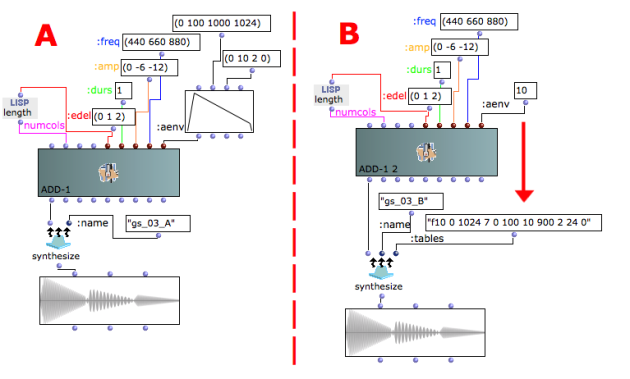Amplitude Envelope
Tutorial Getting Started 03 - Amplitude Envelope
Two different ways to generate the same Amplitude Envelope.
Break Point Function versus GEN Routine
To add keywords to synthesize type "k" ("shift + K" to remove them). To select a given keyword do "alt+click" on the keyword's inlet (dark blue) and choose the desired item from the pop-up menu.
:name is the the audio-file name. One must have different names for audio-files, if one wants to compare them. Otherwise, all the sound rendering will have the default name (my_synt.aiff) and the last rendering will overwrite the old one.
:tables are the Csound's f-tables generator subroutines, or GEN functions. Give the f-statement as in Csound (see the Csound documentation for details), but between double quotes; several tables can also be used if they are placed in a list (of tables between double quotes).
In both examples we have :
3 events one after the other -> :edel 0 1 2 (sec.) with
3 different frequencies -> :freq 440 660 880 (Hz) and
3 different maximum amplitudes -> :amp 0 -6 -12 (dB)
all the events are 1 second long :durs 1 (sec.)
BUT
In example A the Amplitude Envelope is made by a BPF (Break Point Function) which is directly connected to the :aenv slot.
In example B the Amplitude Envelope is made by a GEN subroutine (GEN function number 7, f-table number 10) which is instanciated by the synthesize's keyword inlet (:tables). The number of the f-table is to be specified in the :aenv slot of ADD-1.
Both examples generate exactly the same result.
- OMChroma User Manual
- System Configuration and Installation
- Getting started
- Class Input Slots
- Slots' Description and Default Values
- Amplitude and Internal Editor
- Amplitude Envelope
- f-GEN Reserved Numbers
- Audio Waveforms
- Chord-seq to OMChroma
- Spectrum Chord and Arpeggio
- Velocity versus Amplitude
- Exponential Amplitude Envelope with a BPF
- Relationship with the Csound .orc and .sco files
- Slots polymorphism
- Managing GEN function and sound files
- Predefined Classes
- User-fun
- Creating a new Class
- Multichannel processing
- Appendix A - Common Red Patches

